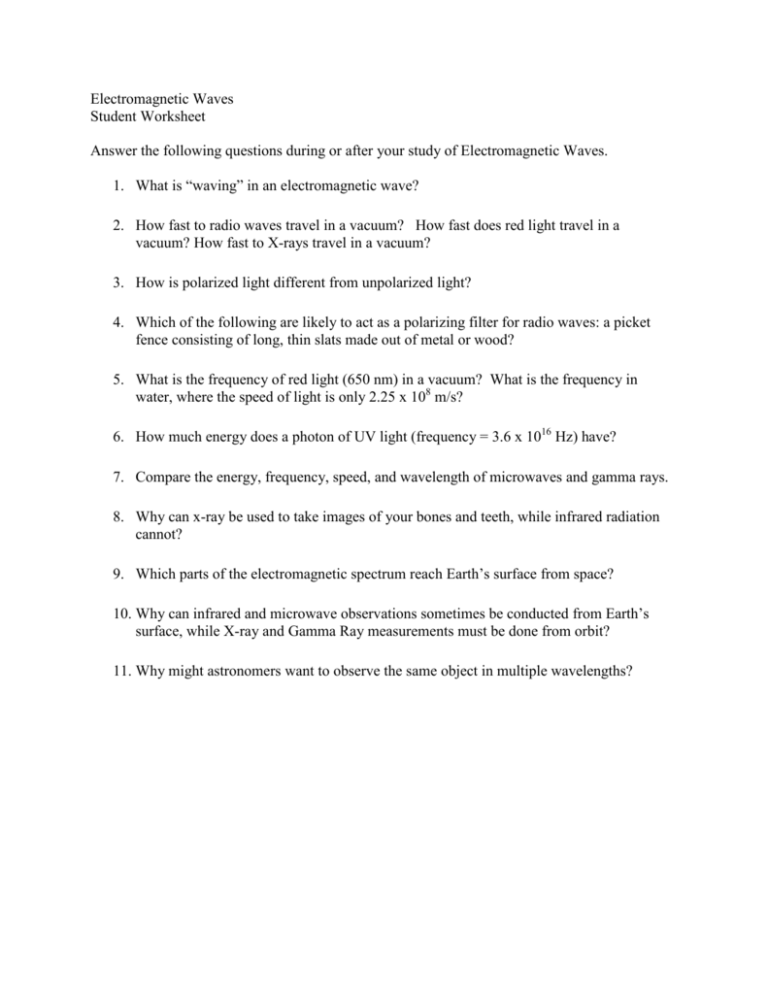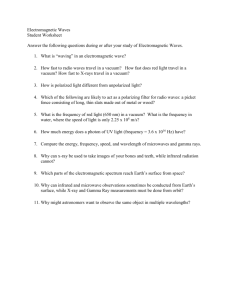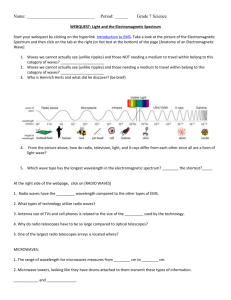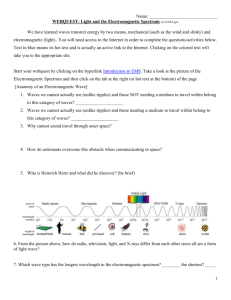Electromagnetic Waves Student Worksheet Answer
advertisement

Electromagnetic Waves Student Worksheet Answer the following questions during or after your study of Electromagnetic Waves. 1. What is “waving” in an electromagnetic wave? 2. How fast to radio waves travel in a vacuum? How fast does red light travel in a vacuum? How fast to X-rays travel in a vacuum? 3. How is polarized light different from unpolarized light? 4. Which of the following are likely to act as a polarizing filter for radio waves: a picket fence consisting of long, thin slats made out of metal or wood? 5. What is the frequency of red light (650 nm) in a vacuum? What is the frequency in water, where the speed of light is only 2.25 x 108 m/s? 6. How much energy does a photon of UV light (frequency = 3.6 x 1016 Hz) have? 7. Compare the energy, frequency, speed, and wavelength of microwaves and gamma rays. 8. Why can x-ray be used to take images of your bones and teeth, while infrared radiation cannot? 9. Which parts of the electromagnetic spectrum reach Earth’s surface from space? 10. Why can infrared and microwave observations sometimes be conducted from Earth’s surface, while X-ray and Gamma Ray measurements must be done from orbit? 11. Why might astronomers want to observe the same object in multiple wavelengths? Electromagnetic Spectrum WS Teacher Notes This worksheet is intended to accompany the Electromagnetic Spectrum PowerPoint (Electromagnetic Spectrum.pptx) created as part of Haystack Observatory’s RET project on Physics and MOSAIC. The PowerPoint can be used as an in-class presentation, but also could be re-envisioned as a Webquest-type activity of self-directed learning. 1. What is “waving” in an electromagnetic wave? Electric and Magnetic Fields are oscillating perpendicular to each other and to the direction of wave propagation. Thus, electromagnetic waves are transverse waves. 2. How fast to radio waves travel in a vacuum? How fast does red light travel in a vacuum? How fast to X-rays travel in a vacuum? All travel at the same speed, c = 299,792,458 m/s, in a vacuum. 3. How is polarized light different from unpolarized light? Polarized light consists of electromagnetic waves that oscillate in only one orientation, while unpolarized light consists of electromagnetic waves that oscillate in many, randomly oriented orientations. 4. Which of the following are likely to act as a polarizing filter for radio waves: a picket fence consisting of long, thin slats made out of metal or wood? The polarizing filter would need to be made out of metal in order to prevent radio waves with a particular polarization (or orientation of electric field oscillations) from passing through the fence. The wood would not impede any of the radio waves. 5. What is the frequency of red light (650 nm) in a vacuum? What is the frequency in water, where the speed of light is only 2.25 x 108 m/s? The frequency is the same in all media. It is equal to f = v/λ, so, using the values for a vacuum, 3.0 x 108 m/s / 650 x 10-9 m = 4.6 x 1014 Hz. 6. How much energy does a photon of UV light (frequency = 3.6 x 1016 Hz) have? Energy is proportional to frequency, and E = hf, so E = 6.626 x 10-34 * 3.6 x 1016 = 2.4 x 10-14 J. 7. Compare the energy, frequency, speed, and wavelength of microwaves and gamma rays. Microwaves have less energy and frequency, but a longer wavelength than gamma rays. 8. Why can x-ray be used to take images of your bones and teeth, while infrared radiation cannot? X-ray photons are much more energetic due to their higher frequency, which means that they are able to penetrate your skin, while IR photons, due to their lower frequency and energy, cannot. 9. Which parts of the electromagnetic spectrum reach Earth’s surface from space? Visible and Radio waves reach Earth’s surface from space. Earth’s atmosphere is transparent in these wavelengths. 10. Why can infrared and microwave observations sometimes be conducted from Earth’s surface, while X-ray and Gamma Ray measurements must be done from orbit? Microwave and infrared are absorbed by the water in Earth’s atmosphere, so, if you can find a location above most of the moisture and away from clouds, you can conduct some of those observations. X-rays and gamma rays, however, are absorbed by the ozone layer, which is much, much higher in the atmosphere, and the only way to get above it is to go into orbit. 11. Why might astronomers want to observe the same object in multiple wavelengths? Different wavelengths provide different information about different processes.









